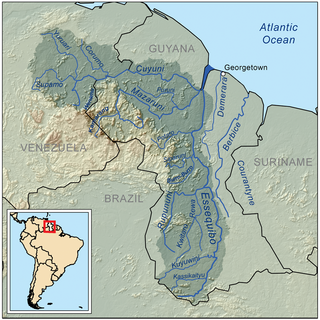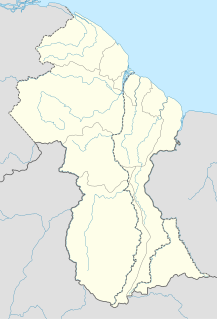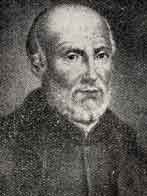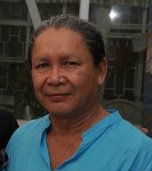Related Research Articles

Heythrop College, University of London was a constituent college of the University of London between 1971 and 2018, last located in Kensington Square, London. It comprised the University's specialist faculties of Philosophy and Theology with Social Sciences, offering undergraduate and postgraduate degree courses and five specialist institutes and centres to promote research. It had a close affiliation with the Roman Catholic church, through the British Province of the Society of Jesus whose scholarly tradition went back to a 1614 exiled foundation in Belgium and whose extensive library collections it housed. While maintaining its denominational links and ethos the college welcomed all faiths and perspectives, women as well as men.

Lethem is a town in Guyana, located in the Upper Takutu-Upper Essequibo region. It is the regional capital of Upper Takutu-Upper Essequibo.

The Rupununi is a region in the south-west of Guyana, bordering the Brazilian Amazon. The Rupununi river, also known by the local indigenous peoples as Raponani, flows through the Rupununi region. The name Rupununi originates from the word rapon in the Makushi language, in which it means the black-bellied whistling duck found along the river.

The Rupununi is a savanna plain in Guyana, in the Upper Takutu-Upper Essequibo region. It is an ecoregion of the Tropical and subtropical grasslands, savannas, and shrublands Biome.
The Macushi are an indigenous people living in the borderlands of southern Guyana, northern Brazil in the state of Roraima, and in an eastern part of Venezuela.

The Wai-wai are a Carib-speaking ethnic group of Guyana and northern Brazil. They are part of the Amerindian population that make up part of South America and are an indigenous group.Their society consists of different lowland forest peoples who have maintained much of their cultural identity with the exception of Christianity which was introduced to them in the late 1950s.
The Wapichan or Wapishana are an indigenous group found in the Roraima area of southern Guyana and northern Brazil.
Charles Evelyn George Cary-Elwes, professed a monk as Dom Columba Cary-Elwes, OSB, of Ampleforth Abbey in York, England. As a missionary he travelled to Uganda, Tanzania and Kenya and has written books on Christianity. He was the founding prior of the Priory of Saints Louis and Mary in Saint Louis, Missouri.

Dadanawa Ranch is located on the Rupununi River in the Rupununi savannah in the Upper Takutu-Upper Essequibo Region of Guyana.

Aishalton is an Amerindian village that is situated in the Rupununi savannah of southern Guyana, in the Upper Takutu-Upper Essequibo Region of the country.
Conrad Gorinsky was a Guyana-born chemist who studied in the UK. The son of Cesar Gorinsky, a Polish cattle rancher and gold prospector, and Nellie Melville, a half-Atorad tribeswoman. He spent months with the Amazonian Wapishana tribe and later obtained US patents for tipir and cunani, two chemicals derived from plants used by the tribe. In 1968 he travelled on a BBC-funded expedition in the Amazon with the explorer Robin Hanbury-Tenison, having a discussion with him that led to the foundation of Survival International.

Julien Maunoir, was a French-born Jesuit priest known as the "Apostle of Brittany". He was beatified in 1951 by Pope Pius XII and is commemorated by the Roman Catholic Church on 29 January and 2 July.
The North Rupununi District in located in south-west Guyana consisting of a mixture of forest, savannah and wetlands ecosystems and is considered one of the most diverse areas in South America. Located on the eastern margin of the larger savannah system which extends into Brazil and is separated by the Ireng and Takutu rivers that come together to form the Rio Branco. The Guyana Rupununi system is divided into the North and South Rupununi by the Kanuku Mountains.

Wowetta is an indigenous village in the Upper Takutu-Upper Essequibo Region in Guyana. The village is mainly inhabited by Macushi people.

George Simon was a Guyanese Lokono Arawak artist and archaeologist. He was the founder and mentor of the Lokono Artists Group, a group of Lokono artists from Guyana, based primarily in Simon's hometown of St. Cuthbert's Mission. Simon was widely regarded as one of the leading Guyanese artists of his generation, and his paintings are notable for their explorations of Amerindian culture and the Guyanese environment. He was also recognized for his achievements as an educator, his efforts to develop opportunities for Amerindian artists in Guyana, and for his work as an archaeologist.
John Peter Bennett was a Guyanese priest and linguist. A Lokono, in 1949, he was the first Amerindian in Guyana to be ordained as an Anglican priest and canon. His linguistic work centred on preserving his native Arawak language and other Amerindian languages; he wrote An Arawak-English Dictionary (1989).

St. Cuthbert's Mission is an Amerindian village on the Mahaica River in the Demerara-Mahaica region of Guyana. It comprises approximately 200 households. St. Cuthbert's is regarded by many people in Guyana as the "cultural capital" for Amerindians.
Ignatius Scoles SJ was a Roman Catholic Jesuit priest, architect and writer. He designed churches and civic buildings and was the son of Joseph John Scoles.
Audrey Joan Butt Colson, is a social anthropologist with a particular interest in the Amerindian peoples of Guyana, Brazil and Venezuela. She was, together with Peter Rivière, one of the pioneers of Amazonian anthropology at the University of Oxford.
Rewa is an Amerindian village in the Upper Takutu-Upper Essequibo region of Guyana.
References
- ↑ "Tipuru celebrates 100 years since arrival of Jesuit missionary | Jesuits in Britain". www.jesuit.org.uk. Retrieved 2021-01-11.
- ↑ "Cuthbert Cary-Elwes, SJ". www.manresa-sj.org. Retrieved 2021-01-11.